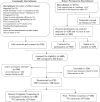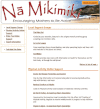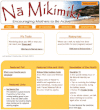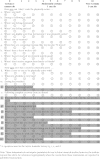Baseline results from Hawaii's Nā Mikimiki Project: a physical activity intervention tailored to multiethnic postpartum women
- PMID: 22533900
- PMCID: PMC3379789
- DOI: 10.1080/03630242.2012.662935
Baseline results from Hawaii's Nā Mikimiki Project: a physical activity intervention tailored to multiethnic postpartum women
Abstract
During the postpartum period, ethnic minority women have higher rates of inactivity/under-activity than white women. The Nā Mikimiki ("the active ones") Project is designed to increase moderate-to-vigorous physical activity over 18 months among multiethnic women with infants 2-12 months old. The study was designed to test, via a randomized controlled trial, the effectiveness of a tailored telephone counseling of moderate-to-vigorous physical activity intervention compared to a print/website materials-only condition. Healthy, underactive women (mean age = 32 ± 5.6 years) with a baby (mean age = 5.7 ± 2.8 months) were enrolled from 2008-2009 (N = 278). Of the total sample, 84% were ethnic minority women, predominantly Asian-American and Native Hawaiian. Mean self-reported baseline level of moderate-to-vigorous physical activity was 40 minutes/week with no significant differences by study condition, ethnicity, infant's age, maternal body mass index, or maternal employment. Women had high scores on perceived benefits, self-efficacy, and environmental support for exercise but low scores on social support for exercise. This multiethnic sample's demographic and psychosocial characteristics and their perceived barriers to exercise were comparable to previous physical activity studies conducted largely with white postpartum women. The Nā Mikimiki Project's innovative tailored technology-based intervention and unique population are significant contributions to the literature on moderate-to-vigorous physical activity in postpartum women.
Trial registration: ClinicalTrials.gov NCT00810342.
Figures








Similar articles
-
Effectiveness of a 12-month randomized clinical trial to increase physical activity in multiethnic postpartum women: results from Hawaii's Nā Mikimiki Project.Prev Med. 2014 Dec;69:214-23. doi: 10.1016/j.ypmed.2014.09.019. Epub 2014 Oct 5. Prev Med. 2014. PMID: 25285751 Free PMC article. Clinical Trial.
-
What barriers thwart postpartum women's physical activity goals during a 12-month intervention? A process evaluation of the Nā Mikimiki Project.Women Health. 2015;55(1):1-21. doi: 10.1080/03630242.2014.972014. Epub 2015 Jan 30. Women Health. 2015. PMID: 25402618 Free PMC article. Clinical Trial.
-
Increasing physical activity in postpartum multiethnic women in Hawaii: results from a pilot study.BMC Womens Health. 2009 Mar 3;9:4. doi: 10.1186/1472-6874-9-4. BMC Womens Health. 2009. PMID: 19254387 Free PMC article.
-
Folic acid supplementation and malaria susceptibility and severity among people taking antifolate antimalarial drugs in endemic areas.Cochrane Database Syst Rev. 2022 Feb 1;2(2022):CD014217. doi: 10.1002/14651858.CD014217. Cochrane Database Syst Rev. 2022. PMID: 36321557 Free PMC article.
-
Interventions for supporting the initiation and continuation of breastfeeding among women who are overweight or obese.Cochrane Database Syst Rev. 2019 Sep 17;9(9):CD012099. doi: 10.1002/14651858.CD012099.pub2. Cochrane Database Syst Rev. 2019. PMID: 31529625 Free PMC article.
Cited by
-
Engineering online and in-person social networks to sustain physical activity: application of a conceptual model.BMC Public Health. 2013 Aug 14;13:753. doi: 10.1186/1471-2458-13-753. BMC Public Health. 2013. PMID: 23945138 Free PMC article.
-
Understanding of Key Obstetric Quality Terminology by Asian and Pacific Islander Subgroups: Implications for Patient Engagement and Health Equity.Matern Child Health J. 2018 Nov;22(11):1543-1549. doi: 10.1007/s10995-018-2597-8. Matern Child Health J. 2018. PMID: 30006728
-
Family-centred interventions for Indigenous early childhood well-being by primary healthcare services.Cochrane Database Syst Rev. 2022 Dec 13;12(12):CD012463. doi: 10.1002/14651858.CD012463.pub2. Cochrane Database Syst Rev. 2022. PMID: 36511823 Free PMC article.
-
Physical Activity Interventions for Postnatal Weight Management: A Systematic Literature Review.Malays J Med Sci. 2023 Dec;30(6):45-53. doi: 10.21315/mjms2023.30.6.5. Epub 2023 Dec 19. Malays J Med Sci. 2023. PMID: 38239246 Free PMC article. Review.
-
Transtheoretical model stages of change for dietary and physical exercise modification in weight loss management for overweight and obese adults.Cochrane Database Syst Rev. 2014 Feb 5;2014(2):CD008066. doi: 10.1002/14651858.CD008066.pub3. Cochrane Database Syst Rev. 2014. PMID: 24500864 Free PMC article.
References
-
- Albright C. L., Maddock J. E., Nigg C. R. Physical activity before pregnancy and following childbirth in a multiethnic sample of healthy women. Women & Health. 2005;42:95–110. - PubMed
-
- Albright C. L., Pruitt L., Castro C., Gonzalez A., Woo S., King A. C. Modifying physical activity in a multiethnic sample of low-income women: One-year results from the IMPACT (Increasing Motivation for Physical ACTivity) Project. Annals of Behav Med. 2005;30:191–200. - PubMed
-
- Austin M.-P., Hadzi-Pavlovic D., Priest S., Reilly N., Wilhelm K., Saint K., Parker G. Depressive and anxiety disorders in the postpartum period: How prevalent are they and can we improve their detection? Archives of Women's Mental Health. 2010;13:395–401. - PubMed
-
- Bandura A. Social foundations of thought and action: A social cognitive theory. Englewood Cliffs, NJ: Prentice Hall; 1986.
